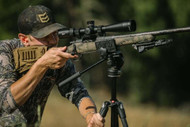Precision Bolt Action Rifle Dream Build
Posted by Red Hawk Rifles on Jun 20th 2024
Precision shooting is a very satisfying skill, but it can require a specialized tool for the best outcome. So today we are going over some things to consider when you are building your dream Bolt Action Rifle.
Some of these things are going to be from a bird’s-eye-view because your preferences will be a factor and not every option is viable for everyone. With that in mind, we are going to look at what you should consider for your precision rifle.
Considerations For Building A Precision
Since we are focusing on a precision rifle, we need to know what a precision rifle should do. This will allow us to focus our build in a specific niche. Generally speaking precision rifles are made for long range shots with the expectation of first round hits .
What’s long range? Well some people will think 800 yards is a long range shot while others only consider shots over 2,000 yards are long shots. So we’ll take 800 yards as the minimum we’ll be shooting at and set 1,000 yards as our average shot.
We are also going to assume that this will not be in a hunting scenario. Bolt Action Rifle 's for hunting and precision rifles do have some crossover but hunting rifles often sacrifice some accuracy for weight savings while precision rifles do not.
Let’s start from the ground up in terms of building a precision rifle.
Action
Most precision rifles are some flavor of bolt action rifle. This is because bolt-actions put more of the cartridge’s energy behind the bullet and have been refined enough to easily meet modern day accuracy requirements.
This means you are looking at some form of Remington 700 (R700) action. These styles of action are very prevalent and there are numerous variations and compatible parts on the market. When choosing an action there are three major considerations: rifle caliber, magazine style, and optic mounts.
Caliber
What caliber you are using will determine what type of R700 action you’ll use. They come in two varieties: short action and long action. Short action R700s are able to accept shorter rounds like .308, .243/6.5, and 5.56 cartridges. Some of these are viable long range but this comes down to the load.
The .308 cartridge is going to be at its effective max at 800 yards for a lot of factory ammo. You can go all the way to 1,200 yards but this comes down to a more fine tuned load. A 6.5 Creedmoor can reach these distances more easily.
Long action R700s are for things like .30-06 and full size magnum rounds (.300 Winchester Magnum and .338 Lapua). These hold a lot of power behind them and the magnums are often the normal option for long distance shots at or beyond 1,000 yards. The only drawback being their heavier felt recoil.
Magazine
Whether your Bolt Action Rifle has a detachable box magazine is another thing to consider. You have two major options: BDL and DBM lower metals on non-chassis systems. The BDL is an internal magazine which allows for it to be flush with the bottom of the rifle. The DBM has a detachable magazine and is usually built in for chassis systems.
Using a detachable magazine is more convenient for reloading and is usually adopted by long range shooters, since they also tend to use chassis systems. This is another item of preference but it is worth leaning towards DBMs for convenience.
Optics mounting
Having a powerful scope (something we’ll cover later) requires you to have some form of optics mounting. Having a picatinny rail on top of your action means you can mount pretty much any optic on the market. This gives you a lot of options and is necessary on any precision rifle build.
Barrel
Now that you have decided on what you want to use for your action we can get into the major factor of the Bolt Action Rifle build, the barrel. The barrel will hold most of the accuracy of the rifle and a poor barrel will not hold as much consistency.
For more traditional precision barrels, bull (bullseye) barrels are still the standard. They are very rigid and add additional weight to the system which can help with accuracy. Modern carbon fiber and fluted barrel options can be good alternatives, but these are for lightweight builds.
Chassis vs Stock
Now comes the choice that brings the gun together. Chassis systems bring more to the modern precision rifle than a composite stock. This is because many chassis systems allow you to mount bipods, additional weights, levels, and anything else you might need for your long range shots. Chassis also generally have adjustable stocks and combs to shape the rifle to you.
Now you can use a composite stock. It will have less modularity but as long as you can adjust the stock and mount a bipod you still get good performance. Ideally either chassis or composite stocks will be used prone or with a tripod to remove as many variables from the shot as possible.
Heavy weight
Why should your precision Bolt Action Rifle be heavy? Well precision rifles are usually using very powerful rounds with a lot of recoil, that extra weight means more force is needed to move the rifle. This translates to lower felt recoil and less shooter fatigue. It also keeps the rifle flatter allowing you to keep your scope on target to call your own shots.
Does this make it more inconvenient to move? Yes, but since most precision rifles are kept in one place after being set up it is a negligible issue. It also beats being tired after a handful of shots when you’re using a magnum load.
Optics
Since you are going to be shooting at such long distances you need a good optic to see what you’re shooting at. This means you should use a scope with a powerful high end magnification. This means greater magnification in the 20x to 35x maximum range rather than the lower 16x options.
Unlike other shooting disciplines you will not need a 1x or 2x baseline, especially at a 1,000 yards. Higher magnifications will have narrow view boxes, but you’re still looking at something 1,000 yards. That 5 to 10 foot view at a hundred yards will more than likely still be something akin to 50 yards at the distances we’re dealing with.
Focal Plane
When choosing a long range scope, most end users will use a second focal plane. This is because at maximum magnification all of the additional features of the scope’s reticle will be functional. At lower magnifications, those features won’t line up due to how second focal plane scopes work.
Another reason is that second focal plane scopes are more affordable, so you can get a good quality scope at a comparatively cheaper price. If you are not going to be doing a lot of target transitions, the second focal plane scope will be just fine.
If you are going to be transitioning from multiple targets at these longer ranges a first focal plane scope will be more useful to you. This is because the scope’s holdovers etc. are constant at any magnification. The reticle will grow and shrink with the magnification but everything is at its true value within that reticle style. But selecting this focal plane comes down to your situation.
Reticle
What type of reticle you use is another personal choice. As long as you know how to use that reticle and its intricacies, it doesn’t matter if it is MOA or MRAD. All you have to do is know the bullet drop and other factors that come into play at the target’s distance and how that works with your preferred reticle system.
Conclusion
Building a purpose driven rifle is a significant investment , especially when you want to push beyond the 1,000 yard mark. Finding the right parts, optics, and everything else is part of the fun and most of the trouble when building a precision rifle.
Thankfully, we have a lot of what you’re looking for available on our website. Check out what we have in stock and don’t put off building your dream Bolt Action Rifle.








